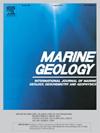石灰岩礁上振荡和单向流动动力学的观测
IF 2.2
3区 地球科学
Q2 GEOSCIENCES, MULTIDISCIPLINARY
引用次数: 0
摘要
天然和人工造礁结构通过衰减入射波和电流能量提供有效的海岸保护。气候变化的预期影响,如海平面上升,威胁到沿海地区,预计将减少珊瑚礁结构对海岸线的保护。本研究旨在调查南澳大利亚罗布的石灰岩珊瑚礁遗址的波浪和洋流动力学,以提高我们对石灰岩珊瑚礁在当今和不断变化的气候条件下如何作为保护性珊瑚礁结构的理解。压力传感器和声学多普勒电流剖面仪部署在跨礁样带上,以研究波浪衰减率,频谱波能量的变化以及电流速度和方向的变化。实地测量表明,镇滩礁作为一个潮汐调制低通滤波器,在较低的水位比较高的水位衰减更多的波浪能量。尽管衰减的波能比其他报告的研究少,但镇滩礁有效地耗散了大约42%的重力波能量,导致低频、次重力波能量在向陆地珊瑚礁保护的泻湖中占主导地位。珊瑚礁向陆地方向的水流速度大约比珊瑚礁向海方向的水流速度低三分之一。双向流动(分别为南北和东西)出现在高水位,在低水位转变为单向流动(分别为南和西)。讨论了这些观察到的动态的潜在原因,并提出了未来的研究,以解决关键的限制,如未知的生态,几何和形态方面的珊瑚礁。本文章由计算机程序翻译,如有差异,请以英文原文为准。
Observations of oscillatory and unidirectional flow dynamics over a limestone reef
Natural and human made reef structures provide effective coastal protection by attenuating incident wave and current energy. Anticipated effects of climate change, such as sea level rise, threaten coastal zones and are predicted to reduce the protection provided to coastlines by reef structures. This study aims to investigate wave and current dynamics at a limestone reef site at Robe, South Australia, to improve our understanding of how limestone reefs act as protective reef structures in present-day and in changing climate conditions. Pressure sensors and acoustic doppler current profilers were deployed on a cross-reef transect to investigate rates of wave attenuation, shifts in spectral wave energy, and changes to current speed and direction. Field measurements indicate that the Town Beach reef acts as a tidally modulated low-pass filter, attenuating more wave energy at lower water levels compared to higher water levels. Despite attenuating less wave energy than other reported studies, the Town Beach reef effectively dissipates approximately 42 % of gravity wave energy, resulting in a domination of lower frequency, infragravity wave energy within the landward reef-protected lagoon. Current speeds landward of the reef are approximately one third lower than those observed seaward of the reef. Bidirectional flows (north-south and east-west, respectively) occur at higher water levels, changing to unidirectional flows (south and west, respectively) at lower water levels. Potential reasons for these observed dynamics are discussed, and future research is proposed to address key limitations, such as unknown ecological, geometric, and morphologic aspects of the reef.
求助全文
通过发布文献求助,成功后即可免费获取论文全文。
去求助
来源期刊

Marine Geology
地学-地球科学综合
CiteScore
6.10
自引率
6.90%
发文量
175
审稿时长
21.9 weeks
期刊介绍:
Marine Geology is the premier international journal on marine geological processes in the broadest sense. We seek papers that are comprehensive, interdisciplinary and synthetic that will be lasting contributions to the field. Although most papers are based on regional studies, they must demonstrate new findings of international significance. We accept papers on subjects as diverse as seafloor hydrothermal systems, beach dynamics, early diagenesis, microbiological studies in sediments, palaeoclimate studies and geophysical studies of the seabed. We encourage papers that address emerging new fields, for example the influence of anthropogenic processes on coastal/marine geology and coastal/marine geoarchaeology. We insist that the papers are concerned with the marine realm and that they deal with geology: with rocks, sediments, and physical and chemical processes affecting them. Papers should address scientific hypotheses: highly descriptive data compilations or papers that deal only with marine management and risk assessment should be submitted to other journals. Papers on laboratory or modelling studies must demonstrate direct relevance to marine processes or deposits. The primary criteria for acceptance of papers is that the science is of high quality, novel, significant, and of broad international interest.
 求助内容:
求助内容: 应助结果提醒方式:
应助结果提醒方式:


